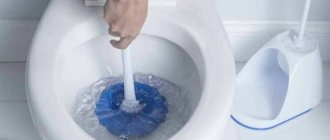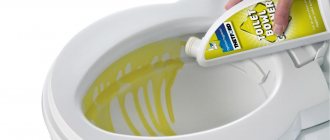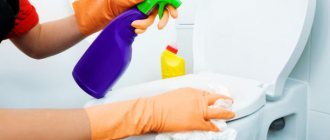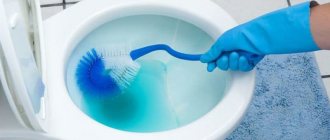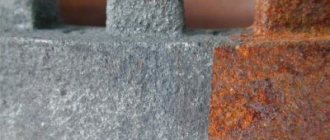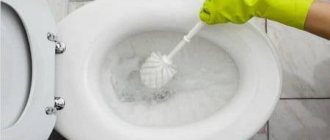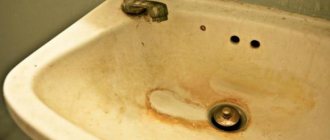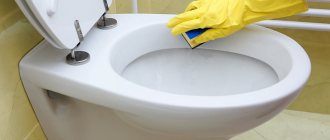Three main enemies of toilet cleanliness
A sparkling clean toilet is a source of pride for any housewife. But, unfortunately, he doesn’t remain that way for long. A short time after cleaning, unpleasant red stains may appear on the surface of the equipment.
These are streaks of rust, a product of the oxidation of iron or other metal alloys. It seems that there is nowhere for it to come from in the toilet, which is made of ceramic with plastic parts.
However, there are several reasons for the appearance of rust. The first is the deplorable state of engineering communications. Old lines were made of non-galvanized metal, which inevitably corrodes over time.
Oxide particles fall into the water, which leaves a rusty mark on the surface of the equipment.
Rust stains are very difficult to remove from a toilet bowl without the use of special cleaning products found in the household or purchased in a store.
Frequent causes of rust stains also include iron-enriched water entering the water supply and leakage of liquid from the tank.
In addition to rust, limescale deposits leave marks on the surface of the toilet. The intensity of its formation depends on the composition of the water used in the water supply system.
It necessarily contains various mineral compounds that settle on the walls of the toilet and form an unpleasant, hard grayish coating. The more lime compounds in the water, the faster plaque appears.
And the third “enemy” of cleanliness of plumbing equipment is urinary stone. It is formed similarly to limescale, the only difference being its composition. The stone is formed from minerals contained in human urine.
When the toilet is used carelessly or when flushed irregularly, urine residues linger on the surface of the toilet, forming a hard coating of an unpleasant brownish-yellow color.
Ideally, you should use a special product for each type of toilet contamination; this makes it easier to deal with them. But universal solutions can also be useful
Thus, there are three main types of toilet contamination. They differ significantly from each other in their chemical composition; accordingly, it will be possible to get rid of them using different means. Although there are universal methods of cleansing that will help in all cases.
I would like to note one more point. All types of contaminants first begin to be deposited where the surface of the toilet bowl has become rough or microcracks have appeared.
Most often, ceramics lose their smoothness after contact with overly hot liquids or objects. Sudden temperature changes are also extremely harmful to the toilet, as microcracks may appear as a result.
You need to know that budget models of plumbing fixtures are made from ordinary sanitary ware with fairly high porosity. This material is prone to the accumulation of contaminants. It is better to purchase equipment made from sanitary porcelain, which has an increased surface smoothness.
Causes of urinary stones and limescale
If dirt and deposits appear in the toilet, take immediate action to avoid unpleasant odors and sediment buildup.
The following types of pollution are formed inside the toilet:
- Urine stone is the result of laziness and carelessness of the owners. Most often, yellow, inconspicuous stains form on the plumbing fixtures of people who forget to flush after themselves. Initially, drops of urine dry out and form a thin hymen. With repeated failure to rinse, a more durable film is formed - urinary stone. You can only get rid of it using special methods, but it is better to prevent its occurrence by carrying out prevention.
Limescale – minerals contained in water (well or river, tap water). The more often you wash off, the more actively a film forms. You need to get rid of limescale regularly, because over time it clogs the holes supplying water to the toilet, which leads to complete failure of the plumbing.
Enameled plumbing is less prone to the formation of plaque that cannot be removed, but on rough surfaces it appears more often and more intensely.
Where to start cleaning?
Whatever method of cleaning the toilet you choose, you should not forget about the preparation stage. First of all, you should take care of protection. All work should be carried out only with rubber gloves.
They will protect the skin on your hands from aggressive cleansers, and you shouldn’t forget about basic hygiene. The toilet is a place where pathogens accumulate.
When working with aggressive chemicals, the use of rubber protective gloves is mandatory. Otherwise, you can develop allergies or dry out your hand skin.
For the same reason, it is advisable to wear an oilcloth or plastic apron. It is good that it covers as much surface as possible. This will prevent germs from getting on your clothes. If aggressive chemicals are to be used, a respirator should not be neglected. The respiratory tract must also be protected.
And a few more words about safety. Try to ensure that cleaning solutions do not come into contact with the skin, much less mucous membranes. If drops of the product do get on them, you should immediately wash them off with water.
When working with products with a strong odor, always leave the door to the toilet room open. The same should be done in the case when gas is formed during the interaction of cleaning agents.
It is advisable to start cleaning the toilet by removing the water. It needs to be scooped out of the device and poured out. For this it is very convenient to use a ladle with a long handle. Only after this can you begin to apply cleaning products.
We fight pollution with folk remedies
Not all housewives are ready to use aggressive chemicals in the fight for cleanliness and prefer to make do with milder “folk” remedies. There is nothing wrong with this, especially since these methods are quite effective.
Especially in the early stages, when plaque and stone have not had time to harden too much. Let's look at how you can clean a toilet using popular gentle methods.
Method number 1 - baking soda with vinegar
It seems that everyone knows how to clean a toilet with soda and vinegar, but there are some nuances here. First, prepare the baking soda; one package will be enough. After this, we moisten the inner surface of the equipment, so we will prepare it for processing.
Fill the toilet with baking soda. It will stick to a wet surface. If there are areas with plaque and stone, be sure to literally coat them with wet soda.
Regular baking soda is a powerful cleaning agent, but it just needs to be used correctly. It is effective both when used separately and when paired with vinegar.
Leave the toilet like this for about half an hour. During this time, the soda will react with the contaminants and begin to destroy them. After the time has passed, take a container with table vinegar. If only essence is available, it is better to dilute it. Carefully pour the vinegar onto the soda-sprinkled surface of the toilet bowl. A violent reaction will begin, which will help remove contaminants.
We take a brush and scrub away the dirt, “helping” the seething chemical reaction. After it’s finished, go over the bowl with a brush again and rinse the toilet thoroughly. It will take several flushes, or if you don’t want to wait for the tank to fill up, you can rinse the equipment with clean water from a bucket.
Method number 2 - mustard powder
First, prepare the cleaning mixture. To do this, take two tablespoons of mustard powder, add an equal amount of crystalline citric acid and four tablespoons of starch.
Mix thoroughly until a homogeneous mixture is obtained. We begin to gradually add clean water. Stir until you get a paste. This will be our cleaning product.
A homemade product based on mustard powder will not only clean, but also disinfect the toilet well. The components included in the mixture are absolutely harmless to plumbing.
We moisten the surface of the toilet so that the mixture sticks better. Carefully distribute the mixture over the bowl. Thoroughly rub the product into particularly contaminated areas and leave it like that for about half an hour. Then rinse with water and at the same time with a brush. Wash off any remaining product with clean water.
Method number 3 - vinegar and salt
This method is especially effective for getting rid of urinary stones. We need one glass of table nine percent vinegar. If it is not there, you can dilute acetic acid according to the instructions, which are usually present on the bottle.
Pour the vinegar into a container that is not afraid of heat, and begin to heat the solution. It is important to remember that at this moment a pungent odor may appear, so it is advisable to close the container tightly.
From the simplest ingredients found in any home, you can create a powerful cleaning product. But it is important to maintain proportions in order to increase the effectiveness of the action.
Heat the vinegar to a temperature of about 40C, then add half a teaspoon of salt and mix well. Using the resulting solution, carefully treat the surface of the toilet. In areas with particularly heavy contamination, increase the amount of product by rubbing it into the stone.
We close the toilet with a lid and leave it in this state overnight. In the morning, remove the solution along with the contaminants by draining the water from the tank.
Method number 4 - wood ash
To prepare the cleaning composition, we need an equal amount of wood ash and crystalline citric acid. Usually, two standard packs of lemon juice and the same amount of ash are enough. Mix everything well.
We moisten the toilet bowl and fill it with the resulting product. Leave it like this overnight. In the morning, clean the toilet with a brush and rinse it, washing off any remaining product.
How to tidy up your toilet cistern
Over time, plaque accumulates on the walls of the tank and deposits form, which affects not only the drainage system, but also the condition of the toilet itself. Thus, rust is fraught with the appearance of yellow stripes in places where water drains, and lime deposits on the bottom impair the tightness of the valve, as a result of which the tank may leak barely noticeably.
To gain access to the inside of the tank, you must remove the lid. How to do it?
- In older float-type models with a side lever, the cover is not secured and can be easily removed by lifting it up.
- In models with a vertical rod (the handle that you pull to drain the water), you should first pull the rod up, unscrew the handle from the thread, and then remove the lid.
- Modern toilets with a push-button flush system are not much more complicated - to dismantle the lid, you need to remove the button along with the rim. This is done like this: press the drain button and, holding it in this state, wrap the rim ring counterclockwise several times; Then you can release the button and freely unscrew the part.
Now it's time to start sanitary and hygienic procedures. The same products that are used to treat the toilet will help eliminate the problem inside the tank: acid-based gels, vinegar, oxalic acid, Coca-Cola, pipe cleaning fluids (see recipes above).
- Method 1. Drain the water from the tank. Pour a bottle of cleaning gel (Sanox, Sanfor, Adrilan) into the bottom of the tank, wait until the tank is filled with water, and leave for 8-10 hours.
- Method 2. Apply a cleaning agent (liquid, acid powder, gel, vinegar with soda) with a sponge to the walls, bottom, parts of the drainage system and wait the required time, then rinse with warm water, drain, and refill the tank.
Acid solutions of different concentrations
As you know, an acidic environment dissolves lime deposits and urinary stone very well. It is also effective against rust, so acids and products based on them are considered a good choice for cleaning the toilet.
In practice, various acids can be used without mixing with other substances. Using phosphoric acid is the best answer to the question of how to clean rust from your toilet.
The substance can easily be bought in a store, where it is sold in the form of an 85% solution. The product is a colorless, syrupy, very aggressive substance. You can only work with it using protection.
Prepare the cleaning product: take half a liter of clean water and dissolve 100 ml of orthophosphoric acid in it, mix until a homogeneous mixture is obtained.
Acids can clean almost any contaminant, but you need to remember that they can ruin the plastic parts of the toilet and pipeline
We degrease the toilet bowl by washing it with any soapy detergent. After this, apply the prepared cleaning agent, treat the surface with a brush, preferably with natural bristles. Leave the bowl with the solution for a while. Depending on the intensity of contamination, it may take from 1 to 12 hours.
After a while, rinse the toilet with a weak soda solution. To prepare it, dissolve a tablespoon of soda in each liter of water.
Hydrochloric acid is also used to remove rust and plaque. But you need to know that it cannot be used for equipment with plastic and rubber parts, and its use is also excluded if the toilet is connected to a plastic pipeline. The acid will dissolve the plastic.
Approximately half a glass of hydrochloric acid is poured into the bowl, where it is left for 15 minutes. Then the surface is washed with clean water.
You can use citric and acetic acid for cleaning. Since their effect is somewhat weaker, this technique gives the best results. Toilet paper is soaked in vinegar and placed under the rim and on contaminated areas.
Do the same with citric acid, but since it is crystalline, it may be more convenient to apply it to a damp cloth. Leave the product on for several hours, preferably overnight. In the morning, rinse with clean water.
Oxalic acid is used similarly to citric acid. This inexpensive product can be purchased at hardware stores.
Oxalic acid is also widely used for cleaning plumbing fixtures. The powder is applied to a damp cloth and applied to contaminated areas.
You can often hear advice on using battery electrolyte as a cleaning agent. This is really effective, but you just need to remember that the liquid contains acids, so don’t forget about caution and protection. Treat the bowl with electrolyte, leave it for 20 minutes, then wash it off with water.
Cleaning products with abrasives
Compositions of this type necessarily contain abrasives. These are very small, but sharp and hard particles, with the help of which mechanical surface treatment is carried out. Abrasives literally peel away dirt, thereby removing it from the surface. They are added in different quantities to cleaning products.
In any case, it is not advisable to use such mixtures on ceramics. This is especially true for sanitary porcelain. Abrasives leave marks similar to scratches on a smooth surface. Over time, more and more of them accumulate, the bowl becomes rough, literally “attracting” dirt.
Powders with abrasives cost very little, so they are very popular. However, you need to remember that solid particles spoil the surface of plumbing fixtures
If you still want to use cleaning products of this type, you should read the instructions on the can. Most often, in addition to abrasives, they contain some kind of bleach. Therefore, most manufacturers advise using their products in this way.
The powder is applied to a sponge moistened with water or directly to the bowl, after which it is intensively rubbed into the surface. Then you should leave the product for a while so that it “works” effectively. Then rub thoroughly with a sponge again and rinse with water.
Industrial cleaning products
This is a large group of different compounds made on the basis of acids or alkalis. The former are more effective, since the acid does a better job of removing rusty swelling and limescale.
But alkaline agents “work” well against organic matter; accordingly, they perfectly decompose urinary stones and fats. Let's look at the most popular formulations.
Gel-like “Cillit Bang” for toilets
All products produced under this brand have a gel consistency. They are packaged in bottles with a convenient spout-shaped dispenser, which helps deliver the solution to the most difficult to reach places.
The main active ingredient in the product is hydrochloric acid. Therefore, it is best used against rust stains and limescale. At the same time, do not forget about protective equipment.
Commercial cleaning products are very effective. You need to know that you cannot mix them. An unpredictable chemical reaction may occur, which is very dangerous
In the line of products you can find compositions of directed action: against rust, for disinfection, for whitening or shine, against difficult to remove limescale deposits. Consumers appreciate the high efficiency of the composition, economical consumption and convenient packaging.
Among the shortcomings, the relatively high cost of the drug is considered the most significant. But the gel is very easy to use. It should be applied to the bowl, left for 15-20 minutes, and then rinsed off.
"Domestos" for the toilet
This brand produces a popular multifunctional product for cleaning toilets and other plumbing fixtures. The product contains alkali, which copes well with the destruction of organic matter. For this reason, the product does not fight limescale very effectively.
In addition, the product contains chlorine bleach, so it not only whitens rust stains, but also disinfects surfaces.
Several varieties of the drug are produced, differing mainly in fragrances. The latter are necessary to drown out the extremely unpleasant smell of chlorine. Consumers highly value the product for its high efficiency, thick consistency and economical consumption. One of the disadvantages is the sharp unpleasant odor of the drug.
Domestos is universal; when diluted, it can be used as a bleach and as a disinfectant for kitchen work surfaces. And in undiluted form, it and other equally effective products can be used to clear blockages in sewer pipes.
Cleaning product “Toilet duckling”
A liquid preparation produced in bottles of a characteristic shape with a strongly curved neck, which allows you to apply the gel in the most difficult to reach places. Duck contains hydrochloric acid, so it copes well with lime deposits and rust stains.
Somewhat worse, but still effective, the drug dissolves urinary stones. The acid concentration is quite high, so the product is aggressive towards bacteria.
Toilet duck is a very effective acid-based product. In addition to universal ones, the manufacturer produces highly targeted drugs to solve various problems.
The drug has a pronounced disinfectant effect. When working with the composition, it is mandatory to use protective equipment. Buyers noted the good effectiveness of the drug, convenient packaging, and budget price.
Duckling contains chlorine derivatives, despite this it has a pleasant smell. The disadvantages include a liquid consistency, which provokes rapid consumption of the drug.
Cleaning tablets and cubes
Many housewives, thinking about how to clean their toilet from urinary stone, do not take into account the numerous tablet cleaning products. They are produced by most manufacturers of household chemicals. This is an effective multifunctional product that can not only clean equipment, but also disinfect it and deodorize the air in the bathroom.
Cleaning tablets for the tank are a practical multifunctional product that deals with three main problems of plumbing equipment at once. The composition of such tablets and the concentration of active substances in them varies depending on the manufacturer.
Well-known brands produce products that are effective for one to two months. The water-soluble coated tablet is dropped into the drain tank. Slowly dissolving, it gradually “releases” the active substances into the water. As a result, the parts of the drain tank are cleaned. After pressing the flush button, the liquid enters the bowl, and it is also cleansed of all types of contaminants.
At the same time, the active substances easily reach the most inaccessible areas and clean them. Products can have a variety of scents; the user chooses any scent they like.
The tablets are quite effective, especially if there are no old contaminants. Among the disadvantages of the product, it is worth noting the rather rapid consumption of the drug, especially if a large number of people use the toilet.
Sink
This item “gets” more than others: more than once a day, family members brush their teeth and wash their hands here (sometimes after very dirty work and activities), the dog’s paws are washed here after a walk, and children rinse their brushes after drawing with paints. In general, stains accumulate quickly.
The good thing is that sinks are usually made of earthenware or porcelain, and therefore the principle of cleaning them is no different from toilets and they are not afraid of chemicals, but you cannot rub them with metal brushes, otherwise you can damage the coating. The recipes already described above with vinegar and soda and lemon are ideal. Only the duration of exposure should be reduced: 15–20 minutes is enough.
You can use natural lemon juice: rub half of the fruit on the affected areas. A pleasant citrus aroma will be a bonus. This method is also suitable for sinks made of artificial stone.
Heavy dirt and deposits can be removed with ammonia. Treat particularly dirty areas with ammonia and then rinse. If you add hydrogen peroxide to it (50 ml of peroxide per 100 ml of ammonia), then this mixture will also get rid of rust.
If you have a stainless steel sink, do not use acid-containing compounds, otherwise discoloration will remain on the sink!
